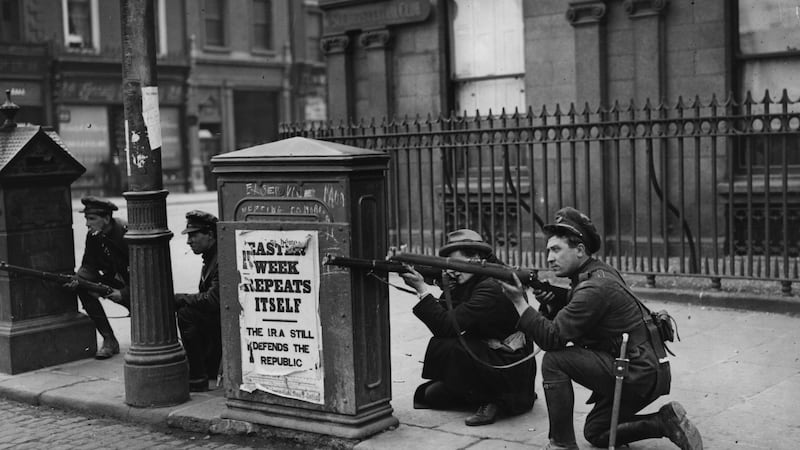The formation of the new Irish State in 1922-1923 was stained by ruthless, internecine violence, north and south of the Border, that cannot be disremembered in 2022. Yet remembering such violence is profoundly difficult.
Let sleeping dogs lie is a powerful doctrine in many post-conflict societies. But in centennial Ireland, an honest interrogation of the violence of the past, and its enduring legacy in the present, is being led by a new generation willing to ask difficult and unsettling questions.
Many personal files that document the lived experience of family members, revolutionaries and civilians a century ago are now widely accessible online. The light these records have shed on women’s experience of war and the Civil War in Ireland is notable.
Paul Ricoeur, the French philosopher underlined the reciprocal but unequal relationship between remembering and forgetting – where there is remembering there is also forgetting. Women’s experience of war has been more often forgotten or considered less significant to the suffering and sacrifices made by heroic men in combat.

The Irish Civil War may not have been a very large or long war but the violence and the trauma it generated in individual families and communities continues to resonate intergenerationally. This internecine conflict was described for decades as a conflict of “brother against brother”. Yet women were active combatants. Serious atrocities against women were also committed both by Anti-Treaty, Pro-Treaty and British forces in the 1922-1923 period.
‘Foul’ attack
Newspapers, pension applications and compensation claims show women and men were comrades and targets. Una McGuill (nee McKeown) was a committed Cumann na mBan member who had lost her job as a teacher in Drumlish, Co Longford because of her activities. She engaged in other risky military actions in the South Armagh/Dundalk region after she married the IRA activist Seamus McGuill, a publican in Dromintee. Una and three other women, including her mother in law, were subjected to a “foul” attack perpetrated by eight A Specials in Dromintee on June 14th, 1922.
Interlinked trauma on both and all sides therefore lives on a hundred years later and these atrocities are still raw and remembered
Subsequent fatal shootings on July 23rd at Edenappa, Jonesboro, Co Armagh, involved the sisters of a comrade of the McGuills, Owen Moore. The victims were Minnie Connolly (20) and Margaret Moore (12), both of whom were shot dead near their home by a party of the Sussex Regiment, stationed at the old Jonesboro police barracks – a few hundred yards north of the Louth border. On the same occasion Mary Moore (18), sister of Margaret Moore was dangerously wounded in her chest and legs and hospitalised for several months after a bullet was removed. They had been delivering supplies to the IRA. An inquiry concluded this was an accident of war.

The Portadown News on July 1st, 1922, reported compensation for the loss of personal belongings on the occasion of the destruction of James McGuill’s dwelling-house and shop at Dromintee on the June 17th. The following claims had been lodged: Lizzie Barry £250; Catherine McBarron £100; Mary McKnight £5O; Annie Hodnett £50. Una, heavily pregnant when “outraged” by three Specials, was not mentioned in the report. The incident at Dromintee preceded the “Altnaveigh massacre” in which six Protestant civilians were subsequently killed in one of the most controversial IRA actions of the revolution (the other being the Dunmanway massacre in Cork). The compensation claims for the subsequent loss of lives in Altnaveigh, documented in this same report, demonstrates the subsequent horror inflicted on other women. Mrs Isabella Heslip of Lisdrumliske witnessed her husband John Heslip, and son Robert, being shot in front of her by the IRA at the entrance to their yard. Elizabeth Crozier and her husband were also shot dead in front of their young family. Interlinked trauma on both and all sides therefore lives on a hundred years later and these atrocities are still raw and remembered on the hills, farms and lanes of the Irish border counties and in other communities impacted by transgressive cycles of violence in this period. Properties were also burned in this episode and families fled south as refugees, including the McGuills.
Gang rape
Protestant and Catholic women, in these instances, were both targeted. Other planned atrocities against women from different backgrounds were also committed by both sides in the Irish Civil War. Three of these include the widely condemned gang rape of Eileen Mary Warburton Biggs in Dromineer, Co Tipperary, by the IRA on June 16th, 1922; an attack on Margaret Doherty, a member of Cumann na mBan, at Currinara in Foxford, by three National Army soldiers on May 27th, 1923; and the flogging of Jessie and Flossie McCarthy in Kenmare in June 1923 by National Army members.
In Maggie Doherty’s case, a pension application made by her mother Catherine, over a period of years, stated she had been raped by National Army forces and included medical evidence and submissions by doctors, religious leaders and members of her community. Eileen Biggs and Maggie Doherty clearly never recovered from the ordeal they experienced. Both died in “mental homes” or psychiatric institutions – Maggie, in Castlebar in 1928; and Eileen in St Patrick’s, Dublin, in 1950. Maggie’s powerful witness testimony in an all-male “Court of Enquiry” held in Ballina in August 1923 describes how three men visited her family home, three times, specifically asking for her. This attack was not opportunistic – the masked raiders knew who they were looking for.
The commemoration of the Civil War in 2022 must find a way to acknowledge and comprehend what happened to Irish women in this period
All of these cases are just some examples of the difficult history of women impacted by the violence of the Civil War and conflict in Northern Ireland, which received no official acknowledgment in the decades after but which firmly remained in the collective memory of their families and communities. Women severely injured by sexual assaults were not killed in combat but they could and did in some cases ultimately die from the trauma or severe injuries, psychological and physical, experienced. Many women quietly shouldered the burden of trauma or injury caused by violence and loss throughout their life.
The commemoration of the Civil War in 2022 must find a way to acknowledge and comprehend what happened to Irish women in this period. In the process of acknowledging that gender-based and sexual violence “happened”, we might remind ourselves that these crimes should not be repeated.











